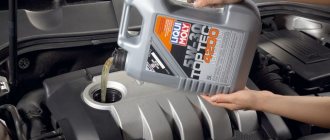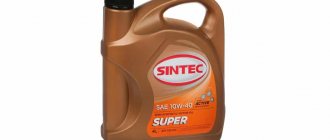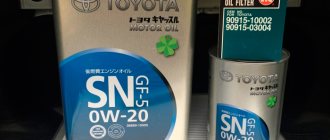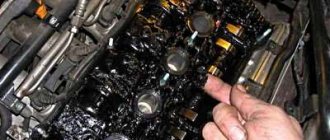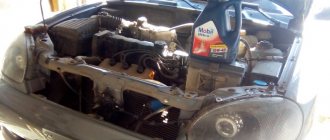Engine QG15DE Nissan
The topic of Japanese cars and the quality of their workmanship is almost limitless. Today, models from Japan can compete with world-famous German cars.
Of course, not every industry is without its drawbacks, but when purchasing, for example, a Nissan model, you don’t have to worry about reliability and durability at all - these qualities are always high.
A fairly popular power unit for some Nissan models is the well-known QG15DE engine, to which quite a lot of space is devoted on the Internet. The motor belongs to a whole series of engines, starting with QG13DE and ending with QG18DEN.
Oils and technical fluids recommended by the manufacturer for NISSAN SUNNY (NISSAN SUNNY)
Here is information about what kind of oil should be filled in for the NISSAN SUNNY engine, what volume of oil in the engine (how much oil should be filled in) NISSAN SUNNY. You will also find information about gearbox oil for NISSAN SUNNY and differential oil.
| Company manufacturer | NISSAN |
| Model name | SUNNY |
| Release start date | 98.10 |
| Release date | 94.09 |
| Body number | GF-FNB15, TA-FBN15 |
| Engine capacity | 1.5 liters |
| Drive and transmission type | 4WD M/T |
| engine's type | QG15DE |
| Engine oil | |
| Oil volume | 2.5 liters |
| Oil volume with filter | 2.7 liters |
| Required oil viscosity SAE | 5W-30(10W30)(0W-20) |
| Required oil according to API/ILSAC classification | S.J. |
| Oil for manual transmission and manual transmission with switch | |
| Oil volume | 3.0 |
| Transmission oil type | Mission Oil MP-G HQ GL-4 75W-90 |
| Switch oil | |
| Oil volume | 0.365 |
| Transmission oil type | Diff Oil Hypoid Super GL-5 80W-90 |
| Differential oil (front drive) | |
| Oil volume | T/M |
| Oil type | |
| Differential oil (rear drive) | |
| Oil volume | 1.0 |
| Oil type | Diff Oil Hypoid Super GL-5 80W-90 |
| Notes | |
Specifications
To understand the capabilities of the engine, you should familiarize yourself with its characteristics in more detail. But it is necessary to clarify right away that this engine was not created with the aim of registering new speed capabilities; the QG15DE engine is ideal for quiet and constant driving.
| Brand | ICE QG15DE |
| engine's type | Row |
| Working volume | 1498 cm3 |
| Engine power relative to rpm | 90/5600 98/6000 105/6000 109/6000 |
| Torque relative to rpm | 128/2800 136/4000 135/4000 143/4000 |
| Number of cylinders | 4 |
| Number of valves | 16 (4 per cylinder) |
| Cylinder block, material | Cast iron |
| Cylinder diameter | 73.6 mm |
| Piston stroke | 88 mm |
| Compression ratio | 09.09.2018 |
| Recommended fuel octane number | 95 |
| Fuel consumption: | |
| – when driving around the city | 8.6 l. per 100 km. |
| – when driving on the highway | 5.5 l. per 100 km. |
| – for mixed driving | 6.6 l. per 100 km. |
| Engine oil volume | 2.7 liters |
| Oil burn tolerance | Up to 500 grams per 1000 km |
| Recommended Engine Oil | 5W-20 5W-30 5W-40 5W-50 10W-30 10W-40 10W-50 10W-60 15W-40 15W-50 20W-20 |
| Change of oil | After 15,000 km (in practice – after 7,500 km) |
| Environmental standard | Euro 3/4, high-quality catalyst |
The main difference from power units from other manufacturers is the use of high-quality cast iron to make the block, while all other companies prefer more brittle aluminum. When choosing a car with a QG15DE engine, you should pay attention to economical fuel consumption - 8.6 liters per 100 km when driving around the city. Quite a good indicator for a working volume of 1498 cm3.
To determine the engine number, for example, when re-registering a car, just look at the right side of the cylinder block of the unit. There is a special area with a number stamped on it. Very often, the engine number is coated with a special varnish, otherwise a layer of rust may soon form.
How much oil to fill in a Nissan Sunny engine
Eighth generation B14, 1993-1998
The eighth generation Sunny was a compact sedan with a length of 4321-4343 mm, and the width and height of the body were 1692 and 1384 mm, respectively. The car's design and interior followed the fashion trends of the 90s: a low roof and low rear, narrow elongated headlights, as well as a strict and ergonomic interior, designed in black tones. In addition to the 4-door model, a five-door station wagon was also produced as a separate model called the Mazda Familia Van. In addition, despite the budget positioning, the Sunny B14 family included a luxury version of Presea with additional exterior design and more advanced equipment.
The eighth generation retained the front-wheel drive layout and transverse arrangement of the internal combustion engine, and offered all-wheel drive as an option. The engine range consisted of in-line 4-cylinder petrol engines. The base unit with a volume of 1.3 liters (GA13DE) developed 84 liters. s., and the more expensive 1.5-liter version (GA15DE I4) produced 100 hp. With. The car was also equipped with engines 1.6 (GA16DE, 100 hp), 1.8 (140 hp) and 2.0 l (SR20DE) with 140 hp. With. In some countries, a diesel modification with a volume of 2.0 liters (CD20) and a power of 75 hp was also offered. With. Transmissions – 5-speed manual or 4-speed automatic. The car had a multi-link rear suspension, which provided high energy consumption and maneuverability on bad roads.
Gasoline engines 1993-1998
- 1.3 GA13DE, oil volume - 3.2 liters, tolerance and viscosity: API-SG, SH, SJ; SAE 5W-40, 5W-30, 0W-40, 0W-30, 10W-40, 10W-30
- 1.5 GA15DE, oil volume - 3.2 liters, tolerance and viscosity: API-SG, SH, SJ; SAE 5W-40, 5W-30, 0W-40, 0W-30, 10W-40, 10W-30
- 1.6 120 l. With. (GA16DE), oil volume - 3.2 liters, tolerance and viscosity: API-SG, SH, SJ; SAE 5W-40, 5W-30, 0W-40, 0W-30, 10W-40, 10W-30
- 1.8 140 l. With. (SR18DE), oil volume - 3.4 liters, tolerance and viscosity: API-SG, SH, SJ; SAE 5W-40, 5W-30, 0W-40, 0W-30, 10W-40, 10W-30
Reliability of the QG15DE engine
How is such a concept as the reliability of a power unit expressed? It’s very simple, it means whether the driver will be able to get to his destination with any sudden breakdown. Not to be confused with service life.
The QG15DE motor is quite reliable, which is due to the following factors:
- Fuel injection system. The carburetor, due to the lack of electronic components, allows you to win in acceleration and jerking from a standstill, but even ordinary clogging of the jets will lead to a stalled engine.
- Cast iron cylinder block and cylinder head cover. A material with a fairly long service life, but does not like sudden temperature changes. Engines with a cast iron block should only be filled with high-quality coolant, preferably antifreeze.
- High compression ratio with small cylinder volume. The conclusion is a longer engine life without loss of power.
The engine life was not indicated by the manufacturer, but from reviews of car enthusiasts on the Internet we can conclude that it is at least 250,000 km. With timely maintenance and non-aggressive driving, it can be extended up to 300,000 km, after which it is necessary to carry out a major overhaul.
The QG15DE power unit is absolutely not suitable as a basis for tuning. This motor has average technical characteristics and is designed only for a calm and smooth ride.
Regulations for changing oil in internal combustion engines
Experienced motorists and experts recommend changing the oil in the Nissan Sunny engine every 10-15 thousand km. The specified regulations can be considered relevant for all cars. In extreme cases, it can be adjusted depending on climatic and road factors, which can negatively affect the quality of lubrication and the service life of engine parts. You will need full control over the quality and condition of the oil, especially after the car’s warranty expires. Failure to comply with basic rules will entail a series of technical problems, the solution of which will require enormous financial costs. So, let's take a closer look at what can happen if you don't change the engine oil on time:
The most popular articles on the site:
- How often should you change engine oil?
- Oil 5w30 and 5w40 what is the difference
- What oil to pour into the engine in winter and summer
- How long does it take to change the automatic transmission oil?
List of main faults and methods for their elimination
There are the most common breakdowns of the QG15DE engine, but with high-quality and timely maintenance they can be minimized or avoided.
Timing chain stretched
It is very rare to see a broken timing chain, but a more common occurrence is a stretched chain. Wherein:
- The engine starts poorly or does not start at all. In this case, it is necessary for the starter to perform long-term work, which also affects its service life.
- The appearance of floating speed at idle.
- Failures in operation are possible, very similar to the consequences of a failed spark plug.
- Increased noise level when the engine is running.
There is only one way out of the situation - to replace the timing chain. Now there are many high-quality analogues, the price of which is quite affordable, so there is no need to buy the original, the service life of which is at least 150,000 km.
The engine won't start
The problem is very common, and if the timing chain has nothing to do with it, then you should pay attention to such an element as the throttle valve. On engines whose production began in 2002 (Nissan Sunny), electronic dampers were installed, the cover of which requires periodic cleaning.
The second reason could be a clogged fuel pump screen. If cleaning it does not help, then most likely the fuel pump itself has failed. Replacing it does not always require the help of service station specialists; this procedure is carried out with your own hands.
And as a last option - a failed ignition coil.
Whistling
Most often occurs when operating at low speeds. The cause of this whistling noise is the alternator belt. You can check its integrity directly on the engine; a visual inspection is sufficient. If there are microcracks or abrasions, the alternator belt along with the rollers should be replaced.
A low battery warning light may indicate that the alternator belt has become unusable. In this case, the belt simply slips around the pulley and the generator does not make the required number of revolutions. When carrying out repairs, you should also check the crankshaft sensor.
Sharp jerks at low speeds
They are especially sensitive when starting to drive and when engaging first gear, and the car also jerks when accelerating. The problem is not critical, it will allow you to get to your home or to the nearest service station, but a solution will require the involvement of a specialist in setting up injectors. Most likely, it is necessary to reflash the ECU system or see how the main adjustment sensors work. This problem occurs on both manual and automatic transmission models.
Catalyst fragility
The consequence of a failed catalyst is black smoke from the exhaust pipe (these are worn-out valve stem seals or rings, as well as a faulty lambda probe), and an increase in CO levels. If thick black smoke appears, the catalyst should be replaced immediately.
Short-lived components of the cooling system
The cooling system for the QG15DE motor does not have a long service life. For example, after replacing the thermostat, after some time you may find drops of coolant, especially in the place where the spark plug well seal is located. Often the pump or temperature sensor fails.
Answers (1)
It is better to fill Nissan Sunny engines with original Nissan 5W-30 or 5W-40 engine oil.
But if it is not possible to buy one, then you can take a non-original one with the appropriate specifications. The replacement volume depends on the engine size; as a rule, up to four liters are enough for a 1.5 liter engine, and up to 5 liters for larger engines.
Replacement frequency: every 10-15,000 km or once a year.
Here are the oils that owners fill in:
Nissan SN KLAN3-05304 5W-30 Texaco Havoline Synthetic 5W-40 Idemitsu “Extreme FS TOURING 5W-40 LIQUI MOLY 5W-40
Checking engine oil in Nissan Sunny
I was getting ready for a long trip and decided to check the fluid levels strictly according to the manual.
Changing the oil in the Nissan Sunny engine (instructions)
Replacing the oil filter, bottom view
If maintenance procedures have not been followed for a long time, the checks and adjustments described below should be performed as necessary.
Timely oil and filter changes are the most important preventative maintenance that an owner can perform on his own. As engine oil ages, it becomes diluted and becomes contaminated, leading to premature engine wear.
Before changing the oil, prepare all the necessary tools and materials. It is best to drain the oil when the engine is warm, since hot oil is quickly and completely removed from the engine, carrying contaminants with it. The work is greatly simplified if the car is standing on an overpass, inspection hole, or raised on a jack and placed on stands. When changing the oil, the vehicle must be maintained in a horizontal position, regardless of the method of lifting, or in such a position that the drain plug of the pan is at its lowest point.
Procedure for changing engine oil
1.
Unscrew the oil filler plug on the cylinder head cover.
2.
Unscrew the drain plug approximately 1/2 turn. Place a container under the stopper and remove the stopper completely. Remove the sealing ring from the plug.
3.
Drain the oil by gradually moving the pan closer to the drain hole.
4.
Wipe the plug and O-ring clean. Check the condition of the sealing ring; if damage is found, replace the ring. Wipe the surface of the pan around the drain hole, put on the ring, screw in and tighten the plug to the specified torque.
5.
The oil filter is located on the right side of the cylinder block, at the rear. Access to the filter is provided from below.
6.
Place a container under the filter.

